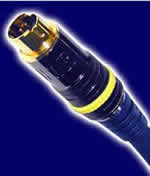|
S-VHS (S-video)
(Good  ) )
Another high quality connection that is only for running
picture. This connection separates luminance and chrominance
to maintain a high quality picture. Will also drive long runs
of cable (10M) provided the cable used is high quality and
well screened.
- Labelled as: Either Y/C, S-Video, S-VHS
or AV1/2/3 (need to check via set-up menu).
- Almost all players have s-video output.
Connect either directly to a TV or to an AV receiver that
can switch s-video.
S-VHS: Potential Perfection
 S-VHS interconnect differs from composite in that it carries the
brightness (luminance, or Y) and colour (chrominance, or C)
signals on separate lines within the same interconnect. S-VHS interconnect differs from composite in that it carries the
brightness (luminance, or Y) and colour (chrominance, or C)
signals on separate lines within the same interconnect.
Every TV has a Y/C separator built in, but using
the S-VHS connection bypasses the TV's Y/C separator. You
should use the S-VHS connection if your source device (such
as a VCR or DVD player) has a better Y/C separator than your
TV.
How do you tell which component - the TV or the
source device - has a better Y/C separator? To start with,
assume that any device that creates separate Y and C signals
from the start has good Y/C separation. With these devices,
you should always use an S-VHS connection if your TV has one.
How to Choose the Right S-VHS Connection If
Your TV Has One.
DVDs contain a composite video signal that must
be separated inside the DVD player to produce an S-VHS output.
The only way you can tell whether you should use composite
or S-VHS connections here is to test them yourself. Connect
an S-VHS interconnect from the DVD player to your TV's video
input 1, and a composite interconnect from the DVD player
to video input 2. Now switch between the inputs to see which
looks best.
S-VHS and Hi8 VCRs can produce perfect Y/C separation,
if the signals on the tape were recorded from a cleanly separated
source. The VCR must separate the Y and C to record tapes
off the air, and it usually does only a fair job. Some prerecorded
tapes are produced with excellent Y/C separation, some aren't.
If you have a TV with a good Y/C separator, using the S-VHS
connection with one of these VCRs will only sometimes produce
a better picture. If your TV's Y/C separator isn't very good,
though-if you see dot crawl and hanging dots on network TV
shows, for example-you're almost always better off using an
S-VHS connection with these VCRs.
S-Video
.jpg) Remember that the component video signal is
split into three parts; black and white information ( Y),
and two colour difference signals ( Pb and Pr).
The S-Video connection keeps the all-important black and white
( Y) information separate, and combines the colour difference
signals into a single colour signal ( C). Instead of
three separate signals going to the display device, there
are now two separate signals. As you would expect, combining
the two colour signals results in a degradation of the colour
information. In the grand scheme of things, this is a fairly
minor degradation, and you still get an exceptionally good
picture from this signal.
|
